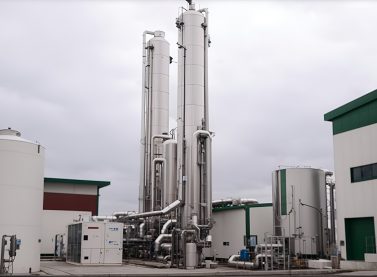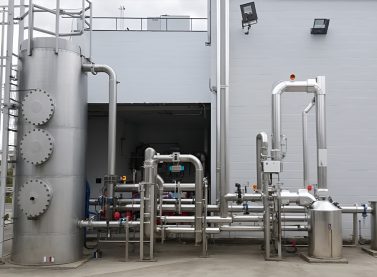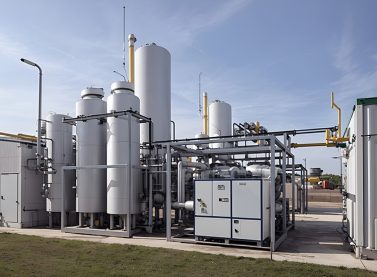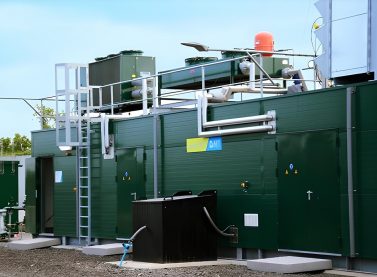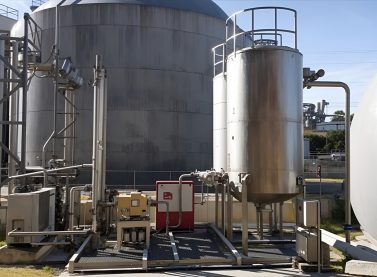Condorchem Envitech offer
CLEAN-BGAS DRY technology combines cooling and condensation techniques which allows an elimination efficiency of over 95% to be achieved, depending on the working temperature, while also offering low operating costs.
This can include a recoverer-washer, which in addition to minimizing the energy needs of the operation, allows the biogas to be washed with its own condensates. This produces a partial reduction of the H2S and NH3, that accompany the biogas, which is why it can be considered a multipurpose technology.
Since the year 2000, Condorchem Envitech has been developing the vertical biogas drying/dehumidification facility, which offers the following benefits:
- Smaller footprint
- Enhanced evacuation of condensates
- Lower probability of freezing in pipes when operating at low temperatures
- Better heat transfer rates
- More efficient moisture and contaminant removal
Our equipment
Removal of water vapour
Water vapour drastically reduces the net calorific value (NCV) of biogas, thereby affecting the energy performance of elements in which it is used as a biofuel (engines, turbines, boilers, burners, etc.). Therefore, prior to using biogas as energy, it is advisable to reduce its moisture content as much as possible by any means available.
Such moisture reduction is also necessary to prevent the accumulation of condensates in the gas line and thus prevent the formation of corrosive acids, as well as the clogging of pipes. The water vapour content of the biogas is directly related to both the operating temperature of the biogas production system and the ambient temperature in general.
CLEAN-BGAS DRY. Biogas drying system
Biogas is a wet gas that needs to be dried for use in order to avoid the:
- Bad operation of CHP systems
- Formation of corrosive acids
- Plugging of the pipes by where the biogas is moved
CLEAN-BGAS DRY is a biogas drying system. It is based on the combination of cooling and condensation. Sometimes works as a scrubber.
Advantages
- Produces a gas stream with low-moisture content
- High elimination efficiency
- Low power consumption
- Low maintenance cost
- Completely automated
- Robust installation
Applications
- Removing water vapour from biogas
- Partial reduction of D-type siloxanes
- Partial reduction of H2S, NH3 and hydrocarbons
- Reduced gas temperature and relative humidity
Technical features
- Modular system
- SContinuous Operation
- It can reduce water vapour and, in turn, H2S, NH3, hydrocarbons and siloxanes as needed
- It can work, both in the suction line or pressure line within the biogas installation
- It may include the operation control system if requested by the client
- Automatic operation
- High biogas moisture removal efficiency
- Could have an energy recovery system or reheating
Technologies and equipment for biogas drying & dehumidification
Biogas production has grown exponentially in recent years and the future looks promising. It is regarded as the main replacement for natural gas, both as fuel for vehicles or for injection into the natural gas network.
Renewable energy, including wind power, tidal energy, solar energy, biomass, and biofuel, is striving to become the leading form of energy production.
Biogas, the gas produced by the anaerobic (oxygen-free) decomposition of organic matter, is amongst the different energy types that have their origin in biomass. It is mainly composed of methane (CH4), which gives it the characteristic of a combustible gas.
Therefore, biogas from landfills, methanisation facilities and wastewater treatment plants (WWTPs) is a valuable material for the production of energy, biofuels and chemical products such as hydrogen and methanol.
From a technical perspective, biogas is a multi-component mixture of gases, with a basic composition (CH4, CO2, H2, O2, N2, water vapour, etc.) and a number of harmful components (NH3, siloxanes, halogenated and heavy hydrocarbons, H2S, etc.). Its composition is closely related to the input material of the anaerobic digestion process, the technology used for its production and the type of process selected.
Biogas quality must be enhanced for application and use in energy production and/or as a raw material in the manufacture of chemical products. Improving biogas quality involves reducing moisture content and removing all the harmful components indicated below.
Biogas drying/dehumidification is understood to be the partial or total removal of the moisture, mainly water vapour, in the biogas stream.
Techniques for separation/removal of moisture (water vapour) from biogas
Many separation/removal techniques are applied to reduce moisture content, including, for example, adsorption with silica gel or dehumidification with glycol. Nonetheless, cooling and condensation are two biogas cleaning techniques/ operations which, in combination, offer very useful benefits. The main aim is to reduce moisture and also to remove, insofar as possible, components such as halogenated and heavy hydrocarbons as well as siloxanes, depending on the operating temperature.
Research on an industrial scale has demonstrated that the lower the cooling temperature used, the more effective the removal of moisture and other components such as siloxanes (mainly type D), and both halogenated and heavy hydrocarbons.
Condensation technique
- Droplet separator
- Hydrocyclones
- Steam traps
- Water seals
- Condensate pots
Drying technique
- Cooling
- Adsorption with silica gel
- Glycol
- Heating
A biogas drying/dehumidification facility normally has the following elements:
- Heat exchanger, generally of the shell and tube type
- Condenser
- Refrigeration unit
- Accessories
A biogas drying/dehumidification facility comprises the following elements: condensate pot, heat exchanger in vertical position, droplet separator and refrigeration unit.
Some biogas drying facilities are equipped with an energy recovery unit/economiser for the purpose of minimising energy consumption required for the operation. Not only does this reduce operating costs, but it also enables lower fixed costs because less powerful refrigeration units can be used. The use of economisers depends on many factors, including the flow of biogas treated, temperature and the purpose of the facility. In 2008, Condorchem Envitech launched a heat exchanger/ economiser-cleaner for biogas cleaning. This system was the result of intensive R&D and affords efficient biogas cleaning combined with minimal energy consumption.
A biogas cleaning facility features an economiser for the purpose of reducing moisture and removing siloxanes and hydrogen sulphide (H2S). The different equipment of which the technology is composed can be seen.
Chillers are at the very heart of biogas drying/ dehumidification processes. They supply the refrigerant, generally glycol water, to cool the heat exchanger where the biogas is cooled. Careful selection of the chiller is therefore vital to the correct operation and durability of the facility.
Current studies related to energy saving at such facilities (large facilities) focus on the use of adsorption chillers and research is being carried out into the use of exhaust gas from the CHP system to generate the refrigeration needed to cool the biogas, thereby closing a particularly interesting energy loop.
There are currently two basic types of biogas drying/ dehumidification facilities on the market, depending on the position of the heat exchanger unit: facilities with a horizontal arrangement and facilities with a vertical arrangement.
